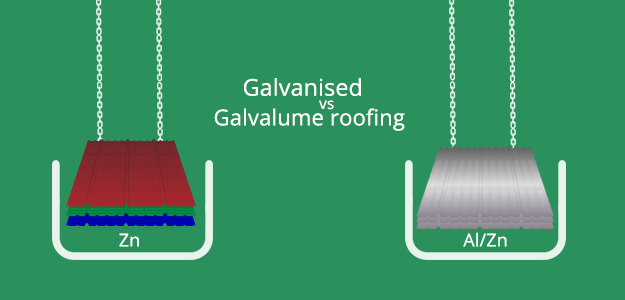
Galvanised vs Galvalume Roofing
April 17th, 2019
Category: All Blogs, Roofing Solutions
The affordability of steel is one of the many benefits that metal roofing affords. While there are several top metal roofing materials to choose from, the one that offers the most bang for your buck is steel metal roofing. However, due to its high iron composition, steel panels are prone to rusting when exposed to moisture and oxygen.
To combat this problem, steel roof manufacturers found the perfect solution – galvanisation. Through a hot-dip process, galvanisation borrows the anti-rusting properties of metals like aluminium and zinc and places them over steel and iron as a protective layer. Here’s a closer look at the two different varieties of galvanised steel.
What is galvanised steel?
As mentioned above, galvanised steel is merely the product of dipping iron or steel pieces into hot zinc. This inhibits rust formation and makes the base material more durable and long-lasting. It creates a protective skin (often called patina) from corrosive elements. Galvanised steel is used in several different products and industries, but is most popular in protective gears, high tension electrical towers, highway signs, wrought iron gates and more recently, metal roofs. For more information on the benefits of galvanised steel, check out our blog!
What is Galvalume?
The simple difference between galvanised steel and galvalume is that while galvanised steel is made with zinc added to the base metal, galvalume requires a combination of zinc, aluminium and silicon. At Dura Roof, our galvalume sheets come with a coating of 55% aluminium, 43.5% zinc and 1.5% silicon, making them highly effective against corrosion and rusting. Galvalume looks similar to galvanised steel, but the visible crystals are smaller and closer together, giving it a smoother appearance.
Where can they be used?
Both galvanised steel and galvalume come with their own set of benefits. For instance, galvalume makes for excellent roofing material in coastal regions and severe marine environments. Galvalume is also best used in prefabricated metal wall panels and in standing seam metal roof applications.
Galvanised steel roofing sheets can be used in agricultural buildings and in modern commercial and residential properties for architects and designers who want to achieve a sleek and sophisticated façade. You can also read our blog on the benefits of using galvanised steel for more information.
What happens to these sheets over time?
Both galvanised steel and galvalume have superior anti-corrosion properties. However, to ensure optimal functionality, you will need periodic maintenance of your metal roof particularly during summer and winter. You can check out our summer maintenance blog, and tips for monsoon roof maintenance for more insights. Having said that, metal roofing sheets are often painted to improve aesthetic appeal, and these special coats of paint also contribute to their anti-corrosive properties. Bare galvalume sheets may lose their shine over the course of their lifetime or develop a patina – a greenish or blue hue which forms over the surface of certain metals with age. Rest assured, however, despite the number of years that pass, time does not affect the quality, durability or performance of metal roofing sheets.
Are there any superior alternatives?
Classic metal roofs began in the 19th century with the Industrial Revolution, where copper roofing was first introduced. Since then, a number of metals have gained popularity as roofing materials including tin, zinc, aluminium, and of course, steel. You can also read our blog on the top 5 metal roofing materials.
Metal roofing systems are extremely popular world over and are here to stay. Time and time again, galvanised steel and galvalume have proved their mettle as durable and resilient roofing materials. If you are considering getting a new roof or replacing your old one, then we recommend opting for either galvanised steel roofing sheets or galvalume sheets. Get in touch with the roofing experts at Dura Roof for more information regarding installation, maintenance, etc.
Leave a Comment

2 Responses received for this post